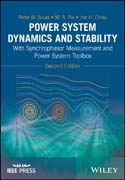
Power System Dynamics and Stability: With Synchrophasor Measurement and Power System Toolbox
Sauer, Peter W.
Pai, M. A.
Chow, Joe H.
Classic power system dynamics text now with phasor measurement and simulation toolbox This new edition addresses the needs of dynamic modeling and simulation relevant to power system planning, design, and operation, including a systematic derivation of synchronous machine dynamic models together with speed and voltage control subsystems. Reduced–order modeling based on integral manifolds is used as a firm basis for understanding the derivations and limitations of lower–order dynamic models. Following these developments, multi–machine model interconnected through the transmission network is formulated and simulated using numerical simulation methods. Energy function methods are discussed for direct evaluation of stability. Small–signal analysis is used for determining the electromechanical modes and mode–shapes, and for power system stabilizer design. Time–synchronized high–sampling–rate phasor measurement units (PMUs) to monitor power system disturbances have been implemented throughout North America and many other countries. In this second edition, new chapters on synchrophasor measurement and using the Power System Toolbox for dynamic simulation have been added. These new materials will reinforce power system dynamic aspects treated more analytically in the earlier chapters. Key features: Systematic derivation of synchronous machine dynamic models and simplification. Energy function methods with an emphasis on the potential energy boundary surface and the controlling unstable equilibrium point approaches. Phasor computation and synchrophasor data applications. Book companion website for instructors featuring solutions and PowerPoint files. Website for students featuring MATLABTM files. Power System Dynamics and Stability, 2nd Edition, with Synchrophasor Measurement and Power System Toolbox combines theoretical as well as practical information for use as a text for formal instruction or for reference by working engineers. INDICE: Table of Contents .Preface xi .1 INTRODUCTION 1 .1.1 Background 1 .1.2 Physical Structures 2 .1.3 Time–Scale Structures 3 .1.4 Political Structures 4 .1.5 The Phenomena of Interest 6 .2 ELECTROMAGNETIC TRANSIENTS 9 .2.1 The Fastest Transients 9 .2.2 Transmission LineModels 10 .2.3 SolutionMethods 15 .2.4 Problems 22 .3 SYNCHRONOUS MACHINE MODELING 25 .3.1 Conventions and Notation 25 .3.2 Three–Damper–WindingModel 26 .3.3 Transformations and Scaling 28 .3.4 The LinearMagnetic Circuit 38 .3.5 The NonlinearMagnetic Circuit 45 .3.6 Single–Machine Steady State 51 .3.7 Operational Impedances and Test Data 56 .3.8 Problems 63 .4 SYNCHRONOUS MACHINE CONTROL MODELS 67 .4.1 Voltage and Speed Control Overview 67 .4.2 Exciter Models 68 .4.3 Voltage RegulatorModels 73 .4.4 TurbineModels 79 .4.5 Speed GovernorModels 85 .4.6 Problems 88 .5 SINGLE–MACHINE DYNAMIC MODELS 91 .5.1 Terminal Constraints 1 .5.2 TheMulti–Time–Scale Model 95 .5.3 Elimination of Stator/Network Transients 97 .5.4 The Two–AxisModel 103 .5.5 The One–Axis (Flux–Decay) Model 105 .5.6 The ClassicalModel 107 .5.7 Damping Torques 109 .5.8 Single–Machine Infinite–Bus System 114 .5.9 SynchronousMachine Saturation 120 .5.10 Problems 127 .6 MULTIMACHINE DYNAMIC MODELS 129 .6.1 The Synchronously Rotating Reference Frame 129 .6.2 Network and R–L Load Constraints 132 .6.3 Elimination of Stator/Network Transients 134 .6.4 Multimachine Two–AxisModel 144 .6.5 Multimachine Flux Decay Model 148 .6.6 Multimachine ClassicalModel 151 .6.7 Multimachine Damping Torques 154 .6.8 MultimachineModels with Saturation 155 .6.9 Frequency During Transients 161 .6.10 Angle References and an Infinite Bus 162 .6.11 Automatic Generation Control (AGC) 164 .7 MULTIMACHINE SIMULATION 173 .7.1 Differential–Algebraic Model 173 .7.2 Stator Algebraic Equations 177 .7.3 Network Equations 179 .7.4 Industry Model 190 .7.5 Simplification of the Two–AxisModel 194 .7.6 Initial Conditions (FullModel) 200 .7.7 Numerical Solution: Power–Balance Form 209 .7.8 Numerical Solution: Current–Balance Form 214 .7.9 Reduced–OrderMultimachineModels 217 .7.10 Initial Conditions 227 .7.11 Conclusion 229 .7.12 Problems 229 .8 SMALL–SIGNAL STABILITY 233 .8.1 Background 233 .8.2 Basic Linearization Technique 234 .8.3 Participation Factors 247 .8.4 Studies on Parametric Effects 253 .8.5 Electromechanical Oscillatory Modes 260 .8.6 Power SystemStabilizers 265 .8.7 Conclusion 288 .8.8 Problems 288 .9 ENERGY FUNCTION METHODS 295 .9.1 Background 295 .9.2 Physical andMathematical Aspects 295 .9.3 Lyapunov s Method 299 .9.4 Modeling Issues 300 .9.5 Energy Function Formulation 302 .9.6 Potential Energy Boundary Surface (PEBS) 305 .9.7 The Boundary Controlling u.e.p (BCU) Method 322 .9.8 Structure–Preserving Energy Functions 328 .9.9 Conclusion 329 .9.10 Problems 330 .10 SYNCHRONIZED PHASOR MEASUREMENT 333 .10.1 Background 333 .10.2 Phasor Computation 335 .10.3 Phasor Data Communication 349 .10.4 Power SystemFrequency Response 350 .10.5 Power System Disturbance Propagation 354 .10.6 Power SystemDisturbance Signatures 361 .10.7 Phasor State Estimation 365 .10.8 Modal Analyses of Oscillations 371 .10.9 Energy Function Analysis 374 .10.10Control Design using PMU Data 377 .10.11Conclusions and Remarks 381 .10.12Problems 382 .11 Power System Toolbox 387 .11.1 Background 387 .11.2 Power Flow Computation 388 .11.3 Dynamic Simulation 395 .11.4 Linear Analysis . . 408 .11.5 Conclusions and Remarks 412 .11.6 Problems 413 .A Integral Manifolds for Model 415 .A.1 Manifolds and IntegralManifolds 415 .A.2 IntegralManifolds for Linear Systems 416 .A.3 IntegralManifolds for Nonlinear Systems 427 .Bibliography 433
- ISBN: 978-1-119-35577-9
- Editorial: Wiley–Blackwell
- Encuadernacion: Cartoné
- Páginas: 376
- Fecha Publicación: 08/09/2017
- Nº Volúmenes: 1
- Idioma: Inglés
